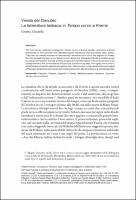Chapter Vineta del Danubio. La letteratura tedesca in Tempo curvo a Krems
| dc.contributor.author | Vivarelli, vivetta | |
| dc.date.accessioned | 2022-06-01T12:23:56Z | |
| dc.date.available | 2022-06-01T12:23:56Z | |
| dc.date.issued | 2021 | |
| dc.identifier | ONIX_20220601_9788855183383_613 | |
| dc.identifier.issn | 2420-8361 | |
| dc.identifier.uri | https://library.oapen.org/handle/20.500.12657/56428 | |
| dc.description.abstract | The five stories in Magris’s Tempo curvo a Krems contain indirect references to the German and Mitteleuropean literatures that nourished their author. They are not merely echoes or resonances: allusions such as to the legend of Vineta, the city beneath the sea, or to Heine’s poem about the troubadour Rudèl and Melisanda, as well as to Faustian themes and the longing for transformation («die and become») are closely linked to the central theme of a circular and recurring time. The lightly ironic tone is nonetheless a bulwark against the spleen, the «Sehnsucht» or the recollection and regret of the past; a past that resurfaces and continues to echo like the tolling of a submerged bell. | |
| dc.language | Italian | |
| dc.relation.ispartofseries | Biblioteca di Studi di Filologia Moderna | |
| dc.subject.other | Faustian Themes | |
| dc.subject.other | Legend of Vineta | |
| dc.subject.other | Mitteleuropean Literature | |
| dc.subject.other | Sources | |
| dc.subject.other | Tempo curvo a Krems | |
| dc.title | Chapter Vineta del Danubio. La letteratura tedesca in Tempo curvo a Krems | |
| dc.type | chapter | |
| oapen.identifier.doi | 10.36253/978-88-5518-338-3.13 | |
| oapen.relation.isPublishedBy | bf65d21a-78e5-4ba2-983a-dbfa90962870 | |
| oapen.relation.isbn | 9788855183383 | |
| oapen.series.number | 59 | |
| oapen.pages | 10 | |
| oapen.place.publication | Florence |

